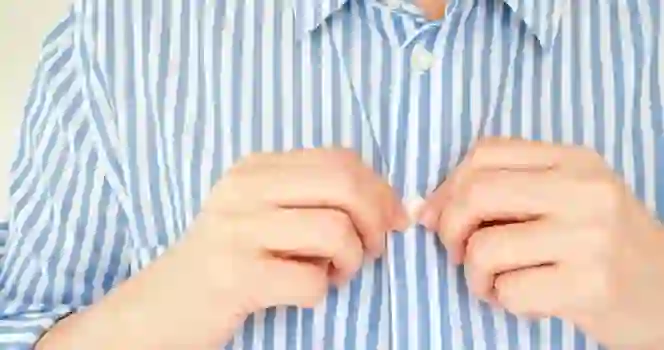
Fashion rules are becoming more fluid these days – what was once specific to men or women is now up for grabs. But there’s one small detail that still sets men’s and women’s clothing apart, and some historians suggest it’s a centuries-old tradition that’s deeply rooted in gender inequality.
The next time you button up your shirt, take a quick look at where the buttons fall on the placket – the reinforced strip of fabric where the button meets the buttonhole. Now, if you happen to have access to a shirt from someone of the opposite gender, take a close look and see if you notice the difference.
Women’s buttons are typically on the left, while men’s are on the right.
The exact origins of the quirky opposite-button design have been lost over time, but experts do have some theories.
Lady’s maid
One of the most widely accepted reasons goes all the way back to when wealthy women didn’t dress themselves. Upper-class ladies often had maids to help them get dressed, and since most people were right-handed, buttons were placed on the left to make it easier for the maid to fasten them up.
“When buttons were invented in the 13th century they were, like most new technology, very expensive,” Melanie M. Moore, founder of womenswear brand, told Today. “Wealthy women back then did not dress themselves – their lady’s maid did. Since most people were right-handed, this made it easier for someone standing across from you to button your dress.”
Meanwhile, men – who usually dressed themselves – had buttons on the right, which was more practical for a right-handed person.
Ready for battle
Other experts suggest that men’s clothing was designed for battle.
Back in the day, many men carried weapons (like swords or pistols) and needed easy access. Since “access to a weapon…practically trumped everything,” having buttons on the right made it easier to unbutton jackets or coats while keeping their dominant hand free for action, Chloe Chapin, fashion historian told Today.
“I think it’s important to question which time period we’re talking about,” Chapin, a Harvard doctoral candidate in American studies, started. “But as a general rule, many elements of men’s fashion can be traced back to the military.”
Women’s fashion, of course, didn’t take battlefield functionality into account – hence, the left-side buttons remained.
Masculine twist
By the 1880s, women’s fashion started adopting more masculine elements, Chapin offered another possible theory.
“It was fashionable for women’s clothing to look more traditionally masculine. However, it was illegal in many places to be dressed like a man in public, so perhaps having a difference in buttoning confirmed that you were wearing a female dress,” the historian said.
Gender inequality
In 1894, British sexologist Havelock Ellis wrote in “Man and Woman: A Study of Secondary and Tertiary Sexual Characters” that women’s garments buttoning right to left was a sign that women were seen as physically inferior to men. He argued that women had weaker motor skills and lacked the “rapidity and precision of movement” of men, who unlike females, did not require assistance when getting dressed.
‘Button differential’
Though this tiny fashion detail has been hiding in plain sight for centuries, people are just starting to realize what The Atlantic called the “button differential.”
It’s “is a relic of an old tradition that we have ported, rather unthinkingly, into the contemporary world,” the publication writes.
And the online community is surprised.
One online user shares on Reddit: “I was today years old when I learned that women’s shirts have buttons on the left side!” And a second writes, “I *just* found out that shirt buttons are on the left for women and right for me. Wtf!!!!”
Others offered their opinions on the centuries-old tradition – steeped in gender inequalities – that continues to influence fashion today.
“Ah yes, the great gender divide – because apparently, centuries ago, women needed help getting dressed while men were expected to fend for themselves. Fast forward to today, and we’re still buttoning up outdated traditions,” tweets one user.
A second Redditor writes, “Zippers too, usually!”
Some brands are now challenging gendered button placement, but most clothing companies still follow the left-for-women, right-for-men rule.
Did you realize that buttons were placed on different sides for men and women? Please let us know your thoughts on this startling revelation and then share this story with your friends so we can hear from them!

